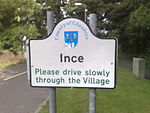Stanlow and Thornton railway station
DfT Category F2 stationsFormer Birkenhead Railway stationsFormer Northern franchise railway stationsLow usage railway stations in the United KingdomPages with no open date in Infobox station ... and 3 more
Railway stations in CheshireRailway stations in Great Britain opened in 1940Use British English from January 2018

Stanlow and Thornton railway station is located within the Stanlow Refinery in Cheshire, England. It lies on the Hooton–Helsby line with services operated by Northern Trains. The station is surrounded by the refinery site, so as a result most station users are refinery employees. In 2018–19 it was the joint least-used railway station in Britain, tied with Denton in Greater Manchester. In 2020/21, the station was also one of the least used stations in Britain, with 0 entries/exits. Since 3 February 2022 the station has been temporarily closed due to safety concerns of the footbridge which is the only entrypoint to the station.
Excerpt from the Wikipedia article Stanlow and Thornton railway station (License: CC BY-SA 3.0, Authors, Images).Stanlow and Thornton railway station
Oil Sites Road,
Geographical coordinates (GPS) Address Nearby Places Show on map
Geographical coordinates (GPS)
| Latitude | Longitude |
|---|---|
| N 53.278 ° | E -2.841 ° |
Address
Oil Sites Road
CH65 4BE , Ellesmere Port
England, United Kingdom
Open on Google Maps









